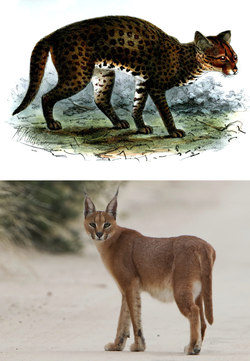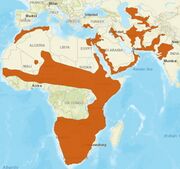Biology:Caracal (genus)
| Caracal | |
|---|---|

| |
| African golden cat (C. aurata) Caracal (C. caracal) | |
| Scientific classification | |
| Domain: | Eukaryota |
| Kingdom: | Animalia |
| Phylum: | Chordata |
| Class: | Mammalia |
| Order: | Carnivora |
| Suborder: | Feliformia |
| Family: | Felidae |
| Subfamily: | Felinae |
| Genus: | Caracal Gray, 1843 |
| Type species | |
| Caracal melanotis Gray, 1843
| |
| Species | |
|
See text | |
Caracal is a genus in the subfamily Felinae of the family Felidae. It was proposed by John Edward Gray in 1843 who described a skin from the Cape of Good Hope in the collection of the Natural History Museum, London.[1] Historically, it was considered to be a monotypic genus, consisting of only the type species: the caracal C. caracal.[2]
Taxonomy
Phylogenetic analysis revealed that caracal, African golden cat (C. aurata) and serval (Leptailurus serval) are genetically closely related forming a genetic lineage that diverged from the common ancestor of the Felidae 7.91 to 4.14 million years ago.[3] This taxonomic classification is used in the IUCN Red List for the African golden cat.[4] It is used as a synonym for the serval.[5]
| Common name | Scientific name and subspecies | Range | Size and ecology | IUCN status and estimated population |
|---|---|---|---|---|
| Double-toothed kite | Caracal caracal (Schreber, 1776) Three subspecies
|
Belize, Bolivia, Brazil, Colombia, Costa Rica, Ecuador, El Salvador, French Guiana, Guatemala, Guyana, Honduras, Mexico, Nicaragua, Panama, Peru, Suriname, Trinidad and Tobago, and Venezuela
|
Size: Habitat: Diet: |
NT
|
| African golden cat | Caracal aurata (Temminck, 1823) Two subspecies
|
Brazil, Paraguay and eastern Bolivia ; winters north to the Amazon basin and the Guyana Shield
|
Size: Habitat: Diet: |
VU
|
References
- ↑ Gray, J. E. (1843). "The Caracal". List of the specimens of Mammalia in the collection of the British Museum. London: The Trustees of the British Museum. p. 46. https://archive.org/details/listofspecimenso00brit_0/page/150/mode/1up.
- ↑ Wozencraft, W.C. (2005). "Genus Carcal". in Wilson, D.E.; Reeder, D.M. Mammal Species of the World: A Taxonomic and Geographic Reference (3rd ed.). Johns Hopkins University Press. p. 533. ISBN 978-0-8018-8221-0. OCLC 62265494. http://www.departments.bucknell.edu/biology/resources/msw3/browse.asp?id=14000013.
- ↑ Johnson, W. E.; Eizirik, E.; Pecon-Slattery, J.; Murphy, W.J.; Antunes, A.; Teeling, E.; O'Brien, S.J. (2006). "The Late Miocene Radiation of Modern Felidae: A Genetic Assessment". Science 311 (5757): 73–7. doi:10.1126/science.1122277. PMID 16400146. Bibcode: 2006Sci...311...73J. https://zenodo.org/record/1230866.
- ↑ 4.0 4.1 Bahaa-el-din, L.; Mills, D.; Hunter, L.; Henschel, P. (2015). "Caracal aurata". IUCN Red List of Threatened Species 2015: e.T18306A50663128. https://www.iucnredlist.org/species/18306/50663128.
- ↑ Thiel, C. (2015). "Leptailurus serval". IUCN Red List of Threatened Species 2015: e.T11638A50654625. https://www.iucnredlist.org/species/11638/50654625. Retrieved 29 October 2018.
- ↑ Fischer, J. B. (1829). "F. caracal Schreb.". Synopsis Mammalium. Stuttgart: J. G. Cottae. p. 210. https://books.google.com/books?id=_no-AAAAcAAJ&pg=PA210.
- ↑ Avgan, B.; Henschel, P.; Ghoddousi, A. (2016). "Caracal caracal". IUCN Red List of Threatened Species 2016: e.T3847A102424310. doi:10.2305/IUCN.UK.2016-2.RLTS.T3847A50650230.en. https://www.iucnredlist.org/species/3847/102424310. Retrieved 15 January 2022.{{cite iucn}}: error: |doi= / |page= mismatch (help)
External links
Wikidata ☰ Q2937805 entry
 |



